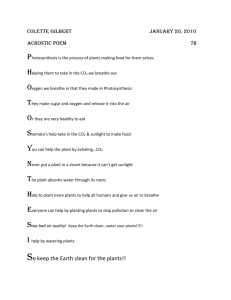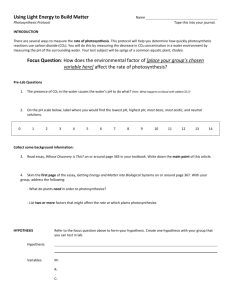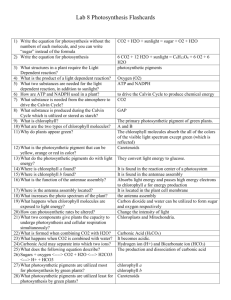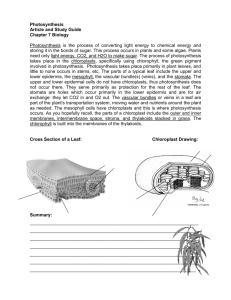Autotrophic nutrition
advertisement
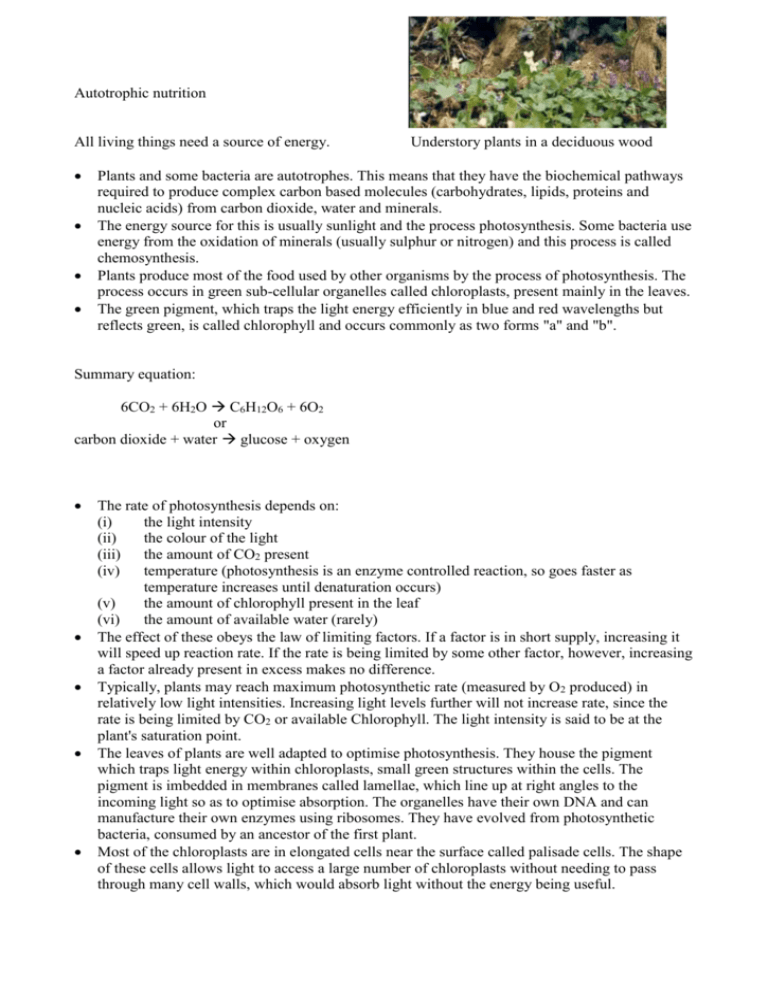
Autotrophic nutrition All living things need a source of energy. Understory plants in a deciduous wood Plants and some bacteria are autotrophes. This means that they have the biochemical pathways required to produce complex carbon based molecules (carbohydrates, lipids, proteins and nucleic acids) from carbon dioxide, water and minerals. The energy source for this is usually sunlight and the process photosynthesis. Some bacteria use energy from the oxidation of minerals (usually sulphur or nitrogen) and this process is called chemosynthesis. Plants produce most of the food used by other organisms by the process of photosynthesis. The process occurs in green sub-cellular organelles called chloroplasts, present mainly in the leaves. The green pigment, which traps the light energy efficiently in blue and red wavelengths but reflects green, is called chlorophyll and occurs commonly as two forms "a" and "b". Summary equation: 6CO2 + 6H2O C6H12O6 + 6O2 or carbon dioxide + water glucose + oxygen The rate of photosynthesis depends on: (i) the light intensity (ii) the colour of the light (iii) the amount of CO2 present (iv) temperature (photosynthesis is an enzyme controlled reaction, so goes faster as temperature increases until denaturation occurs) (v) the amount of chlorophyll present in the leaf (vi) the amount of available water (rarely) The effect of these obeys the law of limiting factors. If a factor is in short supply, increasing it will speed up reaction rate. If the rate is being limited by some other factor, however, increasing a factor already present in excess makes no difference. Typically, plants may reach maximum photosynthetic rate (measured by O2 produced) in relatively low light intensities. Increasing light levels further will not increase rate, since the rate is being limited by CO2 or available Chlorophyll. The light intensity is said to be at the plant's saturation point. The leaves of plants are well adapted to optimise photosynthesis. They house the pigment which traps light energy within chloroplasts, small green structures within the cells. The pigment is imbedded in membranes called lamellae, which line up at right angles to the incoming light so as to optimise absorption. The organelles have their own DNA and can manufacture their own enzymes using ribosomes. They have evolved from photosynthetic bacteria, consumed by an ancestor of the first plant. Most of the chloroplasts are in elongated cells near the surface called palisade cells. The shape of these cells allows light to access a large number of chloroplasts without needing to pass through many cell walls, which would absorb light without the energy being useful. Most of the CO2 needed for photosynthesis enters the leaf via pores on the underside called stomata. These have guard cells which can close at night or during periods of extreme water stress to prevent the plant loosing too much water. The cells between the stomata and the palisade cells are loosely packed (spongy mesophyll cells) and the numerous air spaces allow CO2 to diffuse freely to the palisade cells. Most plants need to keep their stomata open all the time they are photosynthesising, since the O2 produced will break down the enzymes which trap (fix) CO2 if they do not. Some such as maize have evolved protective extra biochemistry which allows them to half close stomata in hot weather, giving the plants considerable advantages in dry climates. Cacti have gone a stage further and store CO2 in the form of organic acids during the night, so that they may photosynthesise with closed stomata during the day. This does of course mean they have to tolerate considerable temperature fluctuations. Plants also have to respire. All living things respire. The roots of a plant have no access to sunlight, so rely on energy formed by respiration of sugars formed in the leaves. The whole plant must respire at night. For this reason, measuring photosynthetic rate by measuring the amount of oxygen produced is not quite accurate. More correctly, it is a measure of the amount by which photosynthesis exceeds respiration. Compensation point is the light intensity at which photosynthesis exceeds respiration for a given plant. In order to survive and grow, a plant must be in an environment where, on average, the available light is above this point. Sun plants, are those which are adapted to live in bright conditions. They tend to have a high rate of respiration and high saturation point. They need to grow fast to stay above competing plants and to be able to resist desiccation (drying out). Because light is not normally the limiting factor, they tend to have small dissected (frilly) leaves. This tends to reduce water loss and promote high CO2 levels. These plants would not survive in the shade, since the ambient light would be below their compensation point. Shade plants, are those adapted to live in low light conditions. They usually have low respiration rates and much lower compensation and saturation points that sun adapted plants. Their leaves are usually larger and rounded, to trap the maximum amount of light. They are less well adapted to resist desiccation, since this is seldom a selection pressure in the shade, but often contain much more chlorophyll. The situation is not quite so straightforward when comparing the leaves at the top and the bottom of trees, but these also show considerable differences - take a look next time you go outside. Marine algae, the seaweeds that you see on the shore, have a more complex problem. Although, in clear water, light may penetrate to considerable depth, water tends to filter out the red light. The algae have evolved extra pigments so that they may trap more of the blue light that remains and pass the energy on to the chlorophyll, which drives photosynthesis. Green algae, such as Ulva (the see lettuce) occur mainly on the upper shore, where their faster growth rate is not inhibited since red and blue light are equally abundant. Brown species, including Fucus vesiculosus (bladder rack) and Fucus serratus (serrated rack) occur in mid shore, where their extra pigments aid absorption of blue light whilst not totally reflecting back the weak red light. Red algae, such as Chondus crispus (Irish moss), occur mainly at the lower shore, where their additional pigments, which would be a disadvantage higher up the shore since they reflect back red light, are here advantageous, since they are highly effective at absorbing blue light The simplest experiments on photosynthetic rate involve the use of a freshwater weed Elodea (an angiosperm = flowering plant, at the opposite end of evolution to the seaweeds mentioned above). This plant is commonly used in aquaria to oxygenate the water. In conditions of even moderate light intensity, it produces bubbles of oxygen which can be collected by putting it in a beaker of water under a glass funnel and collecting the oxygen in an upturned measuring cylinder or specially designed capillary tube apparatus


